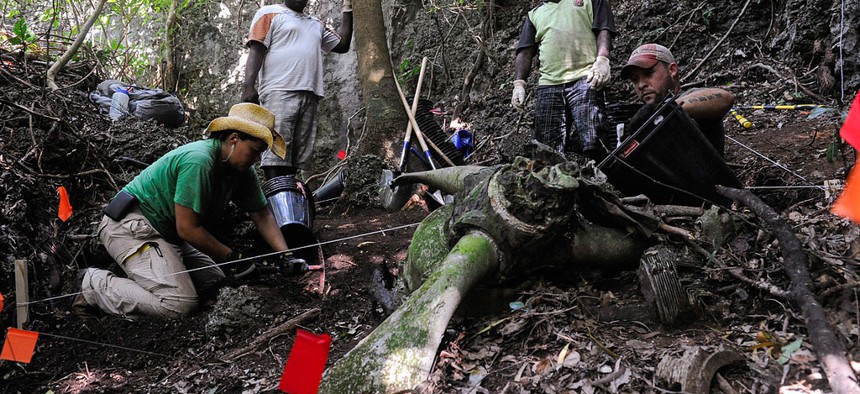
A team from the JPAC conducting an excavation in Mavea Island, Vanuatu DoD photo by Mass Communication Specialist 1st Class Barry Hirayama, U.S. Navy
Hagel Orders a Shakeup of the Pentagon’s MIA Recoveries
After revelations of mismanagement, Defense Secretary Chuck Hagel gives the military 30 days to clean up its MIA command. By Kevin Baron
Defense Secretary Chuck Hagel has given the Pentagon 30 days to deliver a plan to speed up the often painstakingly slow and expensive process of finding, recovering and identifying missing remains of United States troops from previous wars.
Calling it a “top priority for the department,” Hagel ordered a top-to-bottom review of the department in charge of finding and recovering the remains of fallen troops around the world. He also called for a streamlining of the Defense Department’s overlapping and duplicative organizations led by the Hawaii-based Joint POW/MIA Command, or JPAC.
“After intensive review, I have determined that the Department of Defense must change the way it manages accounting for personnel missing from past conflicts,” he wrote. Hagel said the recommendations should serve “to maximize the number of identifications, improve transparency for families, reduce duplicative functions, and establish a system for centralized, complete, fully accessible personnel case files for missing personnel.”
“In fact, we believe it's a sacred obligation,” said Pentagon spokesman Rear Adm. John Kirby, announcing the shakeup at a press conference on Thursday. “We take it seriously and we're going to keep at it. We're going to keep improving.”
Acting Undersecretary of Defense for Policy Michael Lumpkin will conduct the review.
The mission to find, recover and identify the remains of service members – mostly from World War II – is a costly commitment. There are 73,000 unaccounted Americans lost in that war. JPAC said it believes well over 30,000 are recoverable. But often JPAC identifies only a few individuals a month, from all past wars. There are roughly 8,000 missing from the Korean War. In 2013, according to JPAC, the command planned to conduct just 38 recovery missions worldwide.
JPAC officials send teams of troops and civilians, from helicopter pilots to forensic archeologists, into the jungles of Pacific islands, cliffs “over the hump” of Nepal, and fields of France and Germany. They chase thousands of leads by locals who find World War II aircraft and other remains regularly. Then JPAC officials choose which to go after with full-blown archeological digs that can resemble a scene out of Indiana Jones from Papua New Guinea to Vietnam. JPAC says it can costs on average $1 million to recover each soldier.
Now, JPAC’s mission to “bring them home,” which has become unquestionable gospel in American military lore, has come under fire as more lawmakers and media became aware of the high cost and slow rate of the recoveries. Last year, a Government Accountability Office report criticized the organization for mismanagement and waste. In the fall, JPAC was criticized for holding “arrival ceremonies” – where flag draped cases are walked from inbound planes – that were staged, containing no remains. Soon, several media outlets were being told of remains being mishandled or misidentified, leads being ignored and other problems.
Private World War II aircraft wreck hunters and MIA search groups have long charged that JPAC was undermanned and underfunded but also was hostile or unresponsive to private ventures into foreign countries that might disturb crash sites or battlefield graves, risking the loss of a possible identification. Unapologetically, the groups say they are succeeding where the Defense Department has failed.
For Hagel, who served in Vietnam, it is a personal priority.
“As a veteran himself,” Kirby said, “the secretary has an especially personal commitment to ensuring we account for and bring home as many of our missing and fallen service personnel as possible.”
